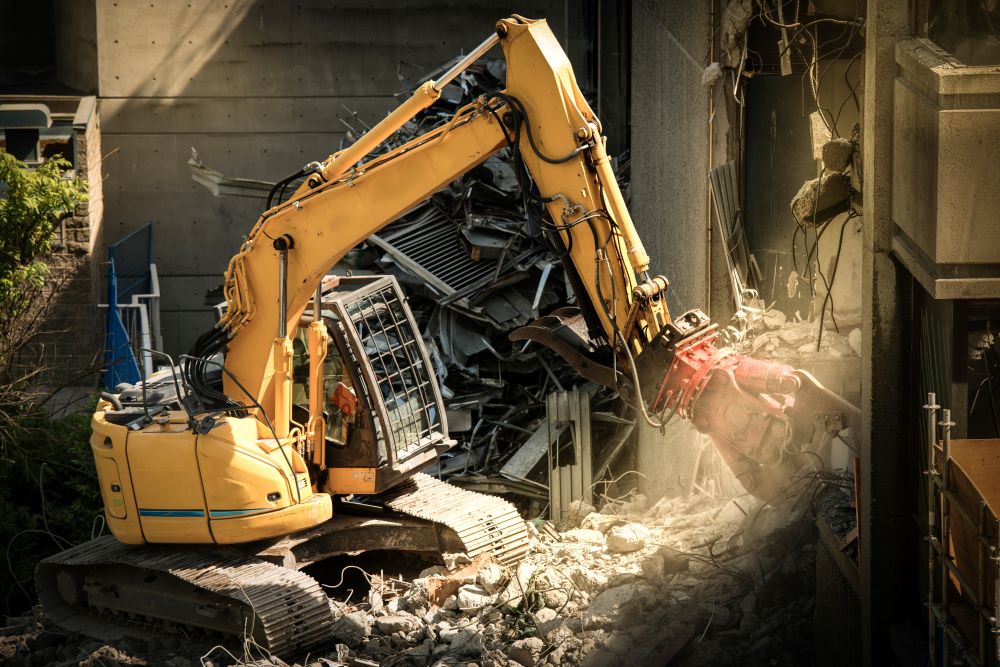
Industrial Demolition Strategies for Business Expansion
There are several aspects to consider while expanding a business. Industrial demolition is one tactic that is often disregarded in this expansion process. Even while it could seem overwhelming, the procedure can open up new doors and encourage creativity in your company.
Imagine reusing property for a more lucrative endeavor or converting an old building into a cutting-edge workplace. In addition to removing the old, industrial demolition techniques provide the foundation for something new that fits with your changing goals. Any organization that is ready to expand may benefit greatly from knowing how to use industrial demolition efficiently, whether the goal is to increase space or replace equipment. Let’s examine in more detail why industrial demolition can hold the secret to growing your business and increasing profits.
OUR SERVICES
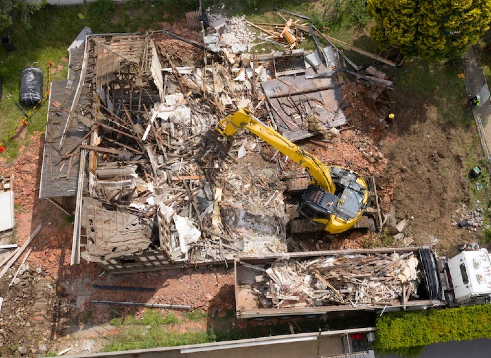
Structure Demolition. Residential, Commercial & Industrial
If your structure poses a health, safety, or environmental risk, demolition can prevent costly citations or fatal accidents. While this may seem daunting, you are just a phone call away from having your residential demolition done professionally, responsibly, and at a great price.
Talk to a Demolition Specialist Now! 916.249.5001
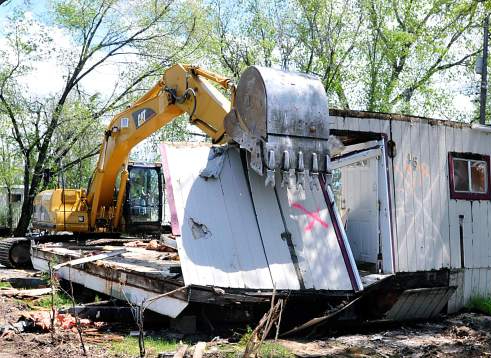
Mobile Home Demolition
We demolish and haul away mobile homes. Any size, anywhere, anyhow. We are fast, clean and competitive. We serve most of Northern California. There are many factors to consider when removing or demolishing your old trailer, mobile home, or manufactured home like: the processes involved, costs, time, contractors, debris, and permits.
Talk to a Demolition Specialist Now! 916.249.5001
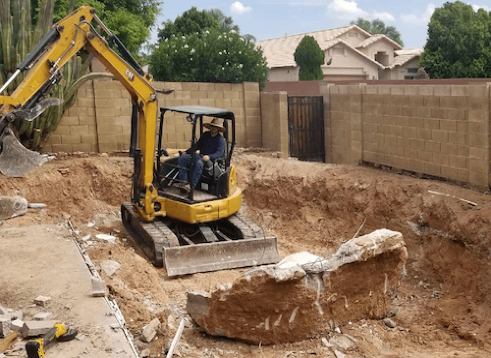
Pool Demolition
When removing a pool in Sacramento, California with the professional demolition team of Maxton Demo, you’re guaranteed peace of mind from beginning to end. From your initial request for an estimate to clean-up, you can expect our pool demolition process that’s completely professional and safe.
Talk to a Demolition Specialist Now! 916.249.5001
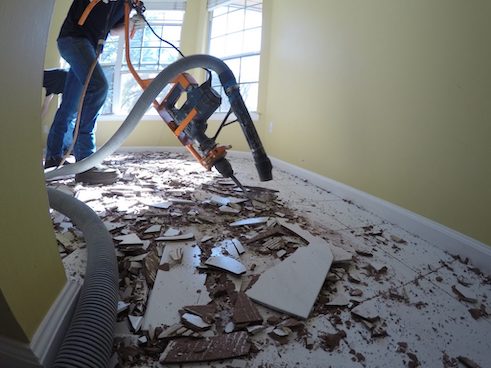
Floor Demolition
Flooring demolition, like any other major home renovation work, requires a specific set of skills and tools to be performed properly. You need experts in flooring demolition to get you the best floors possible. Contact us to find out more about how we can help you today.
Talk to a Demolition Specialist Now! 916.249.5001
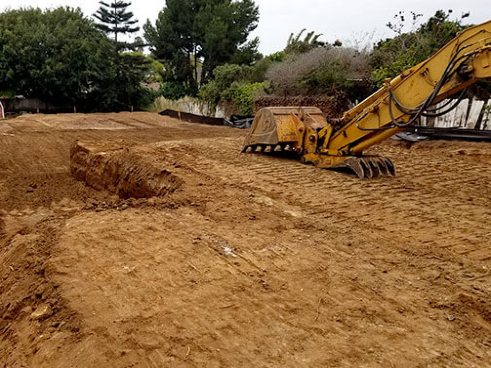
Grading & Excavating
If you need an experienced excavator and grader in Sacramento, call us today. One of the many reasons that residential, commercial, and industrial customers choose to work with us is because we’re able to provide a broad range of services to help construction-related projects get done in less time and at a reduced cost.
Talk to a Demolition Specialist Now! 916.249.5001

Roof Snow Removal
Heavy snow & ice dams can cause significant roof and home damage. Roof Snow removal is our specialty during the winter months. Serving the Sacramento, California area for 10 years, we can get your roof snow removed and promise a quick response and reasonable rates.
Talk to a Demolition Specialist Now! 916.249.5001
Industrial Demolition’s Advantages for Business Growth
Businesses wishing to grow have a plethora of options thanks to industrial demolition. Older buildings may be demolished to free up valuable real estate for businesses. New facilities might be built in this area, increasing operating effectiveness. More space also makes it possible to create new product lines, improve existing equipment, or use new technologies. Higher output and revenues may result from all of these causes.
The chance to update is yet another important advantage. Growth is often impeded by outdated buildings because of their limited layout and architecture. Businesses may build cutting-edge facilities that meet modern demands by demolishing these areas. Consequently, this enhances output and may even raise staff morale.
Additionally, better safety conditions may result from industrial demolition. Older structures could not adhere to modern safety regulations, endangering workers and business operations. Building new infrastructure promotes a safer workplace while guaranteeing regulatory compliance.
Brand image may be improved by investing in industrial demolition. A new appearance conveys innovation and development, drawing in prospective customers and partners that respect cutting-edge methods and modernism in commercial partnerships.
Comprehending the Industrial Demolition Process
There are various crucial phases involved in comprehending the industrial demolition process. The stages in the procedure are as follows:
Evaluation and Planning The first phase of an industrial demolition project is to evaluate the site and create a strategy for the demolition process. This entails examining the building or structure in detail, spotting any possible dangers or hazards, and creating a plan for the safe and effective demolition of the site. Getting any required permissions or approvals from the local government may also fall under this category.
Safety Preparations: Appropriate safety measures must be taken prior to the start of any demolition job. This might include erecting barriers around the property to keep unauthorized people out, protecting services like gas, electricity, and water, and implementing other safety measures to shield employees and other properties from any dangers.
Hazardous Material Removal Before demolition can start, many industrial buildings need to have hazardous items, including chemicals, asbestos, and lead paint, removed. To securely remove these items, a specialist crew will be sent in, according to all relevant rules and regulations.
After the removal of hazardous chemicals, the building’s inner walls, flooring, ceilings, plumbing fixtures, and other non-structural components must be stripped off. This lessens the building’s weight and facilitates demolition, preparing it for destruction.
Demolition Methods Depending on the building’s size and complexity, a variety of demolition methods may be used. These include controlled implosion, which uses carefully placed explosives to bring down the structure in a controlled way; mechanical demolition using heavy machinery like bulldozers and excavators; and manual demolition.
Debris Removal The building’s debris has to be cleared from the site once it has been destroyed. This might include lifting big debris pieces off the site using a crane or loading debris onto vehicles with heavy machinery.
Site Cleanup Following the removal of all debris, the area will be meticulously cleaned, and any hazardous items that remain will be disposed of in accordance with legal requirements.
Final Examination and Closure To make sure that all demolition work has been finished as planned and that the site is safe for use in the future, a final examination will be carried out prior to the project’s formal closure.
Recycling and Salvage After demolition, a lot of industrial components, such as wood, concrete, and metal, may be recycled or salvaged. To recycle these materials and cut down on waste, contractors could collaborate with specialist businesses.
Rebuilding may also be a component of the process, depending on the project. This might include restoring the site to its pre-demolition condition or getting it ready for future building.
All things considered, industrial demolition is a difficult procedure that has to be carefully planned, carried out, and cleaned up to guarantee efficiency and safety. In order to effectively complete the project and safeguard the environment, surrounding properties, and employees, contractors must adhere to stringent rules and regulations.
Selecting the Best Demolition Companies Strategies
A successful job depends on choosing the correct demolition strategy. Investigate nearby companies that specialize in industrial demolition techniques first. Seek out businesses that focus on projects like yours. Verify whether any licenses and insurance coverage are required. To be sure their previous customers were happy with their job, read reviews or get recommendations.
Examine their history. Their dependability and professionalism may be inferred from reviews and testimonials. Experience is crucial when handling complicated demolitions, and a robust portfolio demonstrates this. Verify that they have the tools and equipment necessary to complete your job.
Finally, have a look at their price. Companies that promise very cheap pricing should be avoided because they may not have the skills or tools needed to do the task safely and effectively.
Insurance and licensing are non-negotiable elements. Verify that any prospective contractor has sufficient insurance to cover mishaps or damages and conforms with local laws. A respectable business will be pleased to provide documentation of their insurance and license.
During this procedure, communication is crucial. Select a business that respects openness, informs you at every turn, and responds to your issues right away. Obtain many quotations before deciding. As each firm presents their suggestions, you may evaluate how well they comprehend your unique demands in addition to determining the market pricing.
How Scalable Growth Is Driven by Strategic Demolition
Industrial demolition is a calculated action that may provide new opportunities for company expansion; it goes beyond just demolishing structures. Businesses may successfully use industrial demolition tactics to their advantage by being aware of the advantages, the procedures, and the best firm to work with.
Turning vacant areas into possibilities offers the possibility of growth. Careful planning is essential to success, whether your goal is to construct new facilities or convert property for other purposes. Using effective demolition techniques to adapt as industries change not only opens the door for innovation but also improves safety and compliance.
Purchasing professional services ensures that your project will go without hiccups and in compliance with the law. When properly implemented, these initiatives may be used as a launching pad for more projects and higher profits.
Businesses may reinvent their environments and prosper in cutthroat marketplaces by embracing industrial demolition. Comprehending this potent instrument enables businesses to make well-informed choices about their subsequent growth initiatives.
Techniques for industrial demolition that save expenses and downtime
One of the most important processes in the lifespan of manufacturing and industrial buildings is industrial demolition. Effective tactics are essential when it comes to demolishing an outdated building or making room for new construction. But doing it with accuracy and planning is more important than just demolishing things.
For every company dealing with a demolition project, minimizing expenses and downtime while maintaining safety is essential. The correct strategy may make all the difference, enabling businesses to recover swiftly and affordably.
The Value of Cutting Down on Cost and Downtime
Maintaining company continuity during industrial demolition requires minimizing downtime and expenses. Every hour of interruption might result in lost income and could damage relationships with clients. Furthermore, protracted demolition procedures may result in a notable rise in expenses. Businesses will have to pay more for personnel and equipment if the project takes longer to finish.
Businesses may reinvest resources into new initiatives instead of being distracted by unnecessary costs when these aspects are managed effectively. In addition to increasing profitability, a simplified strategy also improves overall operational efficiency. Because shorter project deadlines result in less emissions and trash, they also lessen the environmental effect of demolition.
Additionally, cutting expenses might result in more aggressive pricing tactics. This gives a business a competitive edge in the market and draws in new customers who are searching for trustworthy service providers. It’s advantageous for companies trying to keep on top of trends.
Businesses may make sure they remain under budget and on time by giving smart demolition tactics first priority. With stakeholders that appreciate responsibility throughout major changes like restorations or demolitions, this builds trust.
Planning and Evaluation Prior to Demolition
An essential part of every industrial demolition project is pre-demolition planning. By spotting possible problems and simplifying processes, it lays the groundwork for success. Businesses may better grasp the project’s scope and foresee potential problems with the aid of a thorough site evaluation.
A comprehensive site evaluation must be carried out during this phase. This includes assessing environmental risks, hazardous compounds, and building integrity. Later on, risk mitigation may be aided by an understanding of these aspects. Additionally, evaluating a site’s state enables companies to identify areas that need more care, which may aid in more effective resource allocation.
Early engagement of important stakeholders promotes cooperation. Throughout the process, communication is improved and regulatory compliance is ensured by interacting with engineers, safety specialists, and local authorities. Additionally, by including the team from the beginning, companies can anticipate any logistical issues and make appropriate plans. This may assist in preventing delays and saving downtime.
One important factor in reducing downtime is creating a thorough timetable. Teams can efficiently coordinate activities and prevent delays that might drive up expenses by outlining each step of the demolition. It’s critical to remember that the schedule should be adaptable enough to accommodate any unanticipated difficulties.
Don’t forget about contingency planning; being ready for unforeseen problems guarantees more seamless phase transitions while safeguarding your financial limitations. In the event of delays, having a contingency plan may assist in reducing downtime and keeping the project on schedule.
Methods of Selective Demolition
The goal of selective demolition methods is to eliminate certain buildings or parts while leaving others intact. In industrial environments where reducing interruption is essential, this approach is becoming more and more common. Techniques for selective demolition include
Soft Demolition: This method entails removing non-load-bearing buildings, including floors, walls, and ceilings, using hand tools or light machinery. For sensitive buildings or locations where there must be as little noise and dust as possible, soft demolition is perfect.
Robotic Demolition: Robotic demolition carries out selective demolition by using remote-controlled equipment equipped with specific attachments. This technique may be used from a safe distance and is perfect for confined or difficult-to-reach areas.
Saw Cutting: Saw cutting is the process of cutting through steel, concrete, and other materials using specialized saws without producing a lot of noise or vibration. Soft demolition methods are often combined with this approach.
Hydrodemolition: This method breaks apart and removes concrete without causing damage to other buildings by using high-pressure water jets. This technique works well for swiftly and effectively removing big volumes of concrete.
Explosive Demolition: This method of controlled explosion is used to destroy certain buildings with the least amount of harm to the surrounding region. This approach requires meticulous preparation and ought to be used only by qualified experts.
Mechanical Demolition: In mechanical demolition, buildings are taken down by the use of large equipment like excavators, bulldozers, or wrecking balls. This approach may be used with other strategies and is perfect for extensive demolition operations.
This method is essential to contemporary industrial demolition plans that put efficiency and cost control first.
Utilizing Technology for Industrial Dismantling
In amazing ways, technology has changed the industrial demolition scene. Precision is improved by sophisticated instruments and equipment, guaranteeing a more effective procedure. For example, before construction starts, drones may do aerial surveys that give information on the site’s conditions.
Additionally, robotic equipment is essential. These devices can carry out dangerous jobs in difficult-to-reach places without endangering human workers. Their well-managed operations cut down on waste and mistakes. The business has also seen a transformation because of 3D modeling technology, which offers intricate visual representations of buildings, facilitating improved planning and execution.
Additionally, improved project management is made possible by software solutions. Teams can keep a close eye on developments thanks to real-time data monitoring, which guarantees that deadlines are fulfilled and expenses are kept under control. The demolition process may also be simulated using 3D scanning and virtual reality technologies, which can help spot any problems before they happen.
Additionally, virtual reality (VR) is becoming more popular. It facilitates cooperative talks on safety precautions and tactics by assisting stakeholders in visualizing demolition plans prior to implementation. Additionally, personnel may be trained using VR and 3D modeling to improve safety procedures and lower hazards.
Businesses that use these technological innovations not only increase productivity but also make workplaces safer while navigating the intricate process of industrial demolition.
Recycling and Waste Management
In every industrial demolition project, efficient trash management is essential. It may drastically cut expenses while minimizing the effect on the environment. Materials that may be recycled or salvaged should be identified and segregated from the rubbish before demolition starts. By doing this, less waste ends up in landfills, and the sale of recycled products may bring in money.
Before demolition begins, a thorough strategy for material separation should be established in order to expedite the process. Recycling concrete, metals, and other recyclables creates new cash sources in addition to lowering landfill contributions.
Sustainability initiatives may be strengthened by making use of nearby recycling facilities. Businesses may make sure that as much material is efficiently reused or recycled as feasible by working with these groups. This method lowers expenses and lessens the demolition operation’ carbon impact.
Additionally, using eco-friendly procedures demonstrates company accountability. It appeals to stakeholders and customers who care about the environment while improving the company’s brand. Hazardous waste disposal has to be given top priority as well. Adherence to laws guarantees on-site security and shields neighboring communities from any hazards related to hazardous materials while demolition is underway.
Rules and Safety Procedures for Industrial Demolition
When it comes to industrial demolition, safety precautions are crucial. With different dangers hiding around every turn, the environment is often surprising. To reduce hazards, all people engaged must get the proper training. This covers utilizing personal protection equipment (PPE), operating equipment, and comprehending safety procedures.
OSHA and other regulatory agencies’ regulations provide precise instructions on safe procedures. These include required safety equipment that must always be worn, such as helmets and safety glasses. To avoid mishaps, appropriate scaffolding and fall protection gear must also be present.
Before any construction starts, site evaluations should be conducted. Teams may take preventative action by identifying possible risks, such as the existence of asbestos or unstable buildings. This might include testing the air quality, removing hazardous contaminants using specialist equipment, or strengthening buildings to stop them from collapsing.
Everyone is prepared for emergencies via regular safety exercises. In the event of a real crisis, this preparedness may greatly lower the number of injuries. Plans for evacuation and appropriate communication procedures must be in place in case of an emergency.
Furthermore, throughout the demolition process, communication is essential. Employees must be fully aware of their responsibilities and report any dangerous situations right away. To guarantee adherence to rules and spot any risks, routine safety audits and inspections should also take place.
Optimizing Value via Cost-Reduction and Downtime-Reduction Industrial Demolition Techniques
Strategies for industrial demolition are essential for controlling expenses and reducing project downtime. Businesses may greatly lessen the effect of demolition operations on overall operations by concentrating on careful preparation. Targeted elimination is possible while maintaining vital systems and buildings when selective demolition methods are used.
Using technology increases these procedures’ efficiency even further. Modern technologies provide decision-makers access to real-time data, which improves resource allocation and shortens project schedules. Furthermore, a focus on waste management guarantees the appropriate handling of recyclable materials, supporting sustainability initiatives.
In industrial demolition, safety is still of the first importance. Following the law reduces possible liability for companies engaged in such endeavors while also protecting employees. Using thorough industrial demolition techniques helps to minimize operating interruptions and keep expenses under control while facilitating a more seamless transfer from outdated facilities to new initiatives. For businesses hoping to prosper in a constantly changing industrial environment, this strategy is essential.
Do you have a Question?
Talk to a Demolition Specialist Now! 916.249.5001
Request Formal Quote